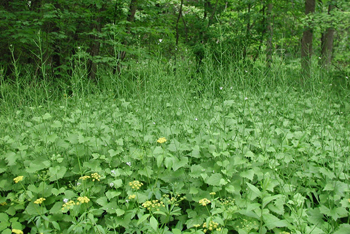 CFAES’s Kathy Smith and Marne Titchenell want to give honeysuckle the boot. Along with garlic mustard, autumn olive, buckthorn and many others. They’ll show how to do it in a workshop in northeast Ohio.
CFAES’s Kathy Smith and Marne Titchenell want to give honeysuckle the boot. Along with garlic mustard, autumn olive, buckthorn and many others. They’ll show how to do it in a workshop in northeast Ohio.
The event is called Forest Health: Non-Native Invasive Plants. It’s on May 20 at Kirtland’s Holden Arboretum.
The Ohio Woodland Stewards Program is the workshop’s sponsor. The college’s outreach arm, OSU Extension, runs the program.
They weaken the health of a woods …
Invasive woodland plants pack a double whammy, said Smith, who’s the coordinator of the program. The plants weaken both a forest and the wildlife that lives there — or used to — by choking out native trees, shrubs and wildflowers and by changing the habitat and food available.
Previous research by the college has shown that the non-native, widespread Eurasian honeysuckle, for example, lowers the numbers and nesting success of birds like the Acadian flycatcher, raises nest predation on birds like cardinals, and ups the risk of nest parasitism by cowbirds.
“Some invasive species have more impact on wildlife than others,” Smith said. “But they all have a negative impact on forest health.”
… and also the health of its wildlife
Titchenell, who’s a wildlife specialist in the college, has expertise on topics such as bats, birds, mammals and amphibians and what they need for their habitat. Also speaking at the workshop will be staff from the arboretum.
Identifying invasive plants, landowners’ and homeowners’ control options, and the arboretum’s own control efforts are all on the program’s agenda.
Kudzu, burning bush and Oriental bittersweet, to name just a few, will also be some of the plants that are covered — and hopefully later defeated.
Make it a plan to fight them
“It’s great to see a woods that is ‘non-native invasive plant-free,’ ” Smith said. “But we always caution that it’s not a one-and-done situation.
“Monitoring and removing non-native invasive plants needs to be part of the regular management plan for a woodland. If it’s not, the plants will quickly reinvade.”
The program is from 9 a.m. to 3:30 p.m. in the arboretum at 930 Sperry Road in Kirtland.
Registration is $35, includes lunch and materials, and is needed by May 13. A complete agenda and mailable registration form can be downloaded at go.osu.edu/May2016Woods. Participants also can register online at go.osu.edu/May2016WoodsReg.
For more information, call 614-688-3421.
(Photo: Leslie J. Mehrhoff, University of Connecticut, Bugwood.org.)